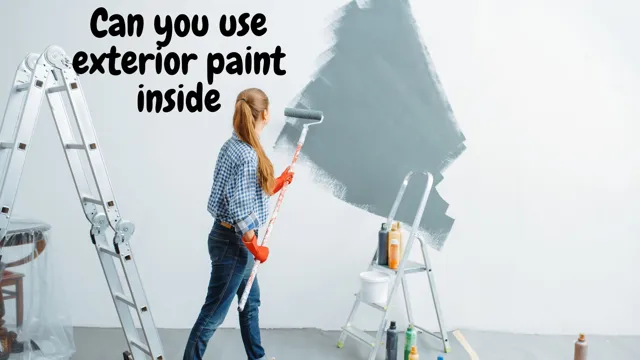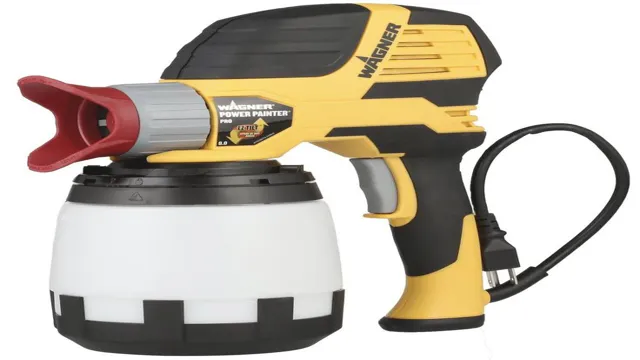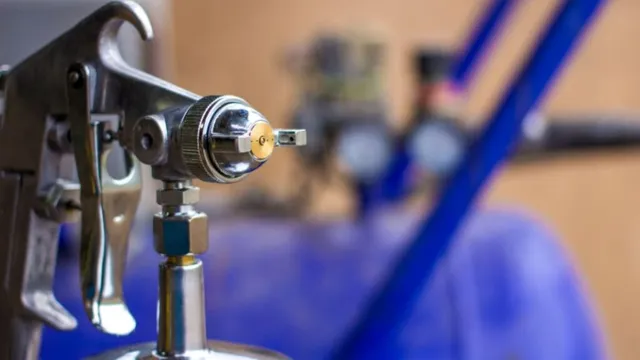Can You Use an Exterior Paint Sprayer Inside? Tips and Precautions.

Thinking of giving your home a makeover by painting its exterior walls? It’s a great idea, but before you go on ahead with it, you need to know some crucial things about using an exterior paint sprayer indoors. Sure, it can be tempting to breeze through the process with a sprayer, but not all sprayers are created equal, and not all spaces are suited for this method. In fact, using an exterior paint sprayer come with a unique set of challenges if done indoors.
From technical considerations to safety concerns, this guide will give you a comprehensive understanding of what you need to know before spraying away. So, let’s dive in and make sure that your next painting project is a success!
Understanding the Basics of Exterior Paint Sprayers
When it comes to painting the exterior of a home, using an exterior paint sprayer can make the job much easier and faster. However, many people wonder if it’s safe to use these sprayers indoors. The answer depends on the type of sprayer you have.
Airless sprayers, which use high-pressure to atomize the paint, should never be used indoors as they can create a fine mist that can settle into furniture, carpets, and other surfaces. On the other hand, HVLP (high-volume, low-pressure) sprayers are a safer choice for indoor use as they produce less overspray and are less likely to create a mess. It’s important to remember that even with an HVLP sprayer, proper ventilation and safety precautions such as wearing a mask and goggles should be taken.
In conclusion, with the right type of sprayer and safety measures in place, it’s possible to use an exterior paint sprayer indoors, but proceed with caution.
Different Types of Paint Sprayers
When it comes to painting the exterior of your home, using a paint sprayer can save you a lot of time and effort. However, there are different types of paint sprayers, and understanding the basics of each one can help you choose the right one for your needs. Airless paint sprayers are powerful and versatile, able to handle a variety of coatings and surfaces, making them perfect for larger projects.
HVLP paint sprayers use high volumes of air to atomize the paint, making them ideal for finishing work and smaller projects. Finally, compressed air paint sprayers use compressed air to spray the paint, offering a high-quality finish but requiring more maintenance. By taking the time to understand the differences between these types of paint sprayers, you can make an informed decision on which one will work best for your project.
So, whether you’re looking to paint your entire home or just touch up a few areas, using the right exterior paint sprayer can make all the difference in the world.

Features of Exterior Paint Sprayers
Exterior paint sprayers are an excellent choice for anyone looking to give their home a fresh new look. Understanding the basics of these sprayers is essential before making a purchase. One of the main features of exterior paint sprayers is their ability to cover a large area in a relatively short amount of time.
This means you can paint your entire house in an afternoon, rather than over several days with a traditional paintbrush. Additionally, some models feature adjustable spray patterns, allowing you to control the amount and direction of the paint being applied. Another advantage of using an exterior paint sprayer is that it creates a more even application than a traditional brush, resulting in a smoother finish.
When selecting an exterior paint sprayer, it’s important to choose a model with the appropriate pressure and nozzle size for your project. By understanding the basics of exterior paint sprayers, you can easily select the perfect model to achieve a professional-looking finish on your home.
Potential Risks of Using Exterior Paint Sprayers Indoors
A common question asked by many DIYers is whether or not they can use an exterior paint sprayer to paint the inside of their homes. While it might seem logical to use a tool designed for outdoor use to tackle an interior painting project, there are potential risks involved. One of the biggest concerns is the release of harmful fumes.
Exterior paint is typically designed to withstand the elements and contains more volatile organic compounds (VOCs) than paint intended for indoor use. Using an exterior paint sprayer indoors can fill your home with these toxic fumes, which can cause headaches, dizziness, and other health problems. Additionally, exterior paint sprayers are typically designed for larger scale projects, making it difficult to control the amount of paint being released and increasing the likelihood of overspray or accidents.
In conclusion, using an exterior paint sprayer to paint indoors is not recommended due to the potential health risks and issues with control. It’s best to stick with tools and paint specifically designed for interior use to ensure a safe and successful project.
Toxicity of Paints and Chemicals
If you’re considering using exterior paint sprayers indoors, there are potential risks that you need to be aware of. One of the biggest risks is the toxicity of the paints and chemicals involved. Exterior paints often contain chemicals that release volatile organic compounds (VOCs) into the air, which can be harmful to your health if you inhale them in large amounts.
In fact, studies have shown that long-term exposure to VOCs can cause a variety of health problems, including respiratory issues, headaches, and dizziness. In addition, the use of paint sprayers can create a burst of toxic fumes that can linger in the air for a while, even after the painting is done. To minimize the risks associated with using exterior paint sprayers indoors, it’s important to properly ventilate the area, wear protective gear like masks and goggles, and use low-VOC formulas for your paint.
By taking these precautions, you can ensure that your indoor painting project doesn’t have any negative impacts on your health.
Poor Air Circulation and Ventilation
Using exterior paint sprayers indoors can pose a significant risk to your health due to the poor air circulation and ventilation in most indoor spaces. The fumes from paint contain harmful chemicals that can cause a wide range of health problems, including respiratory issues, headaches, and nausea. Inhaling these fumes can be particularly dangerous for people with asthma or other pre-existing conditions.
It’s essential to ensure proper ventilation and air circulation when using a paint sprayer indoors to eliminate any potential health risks. Moreover, it is recommended to use a paint sprayer with low VOC (volatile organic compounds) as it reduces the chances of getting in contact with harmful chemics. Using a paint sprayer indoors without proper precautions can increase the risk of developing chronic health problems.
So, it is always advisable to take proper safety measures before starting any indoor painting project and always use the right equipment and a suitable paint sprayer to protect your health and wellbeing.
Poor Quality of Results
Exterior paint sprayers may seem like a convenient tool for indoor projects, but they pose potential risks if not used properly. One of the main concerns is the poor quality of results that can occur due to overspray and uneven application. Paint can easily drift or mist onto unintended surfaces, causing an unsightly mess and requiring additional time and effort to clean up.
Additionally, the high pressure and volume of paint being sprayed can create drips and runs, resulting in a blotchy or streaky finish. To avoid these issues, it’s important to follow proper safety measures and choose the appropriate equipment for the job. Using a handheld sprayer with adjustable settings or opting for a brush and roller may provide a better finish and reduce the risk of damaging surrounding areas.
Ultimately, taking the time to carefully assess the situation and make informed decisions can help ensure a successful and safe outcome for any interior painting project.
Precautions to Take When Using Exterior Paint Sprayers Indoors
Using an exterior paint sprayer inside can be a great way to get the job done quickly and efficiently. However, it is important to take certain precautions to ensure the safety of everyone involved. First and foremost, make sure to properly ventilate the area.
This means opening windows and using fans to circulate air. You should also wear a mask and goggles to protect your lungs and eyes from the paint mist. Another important precaution is to cover furniture and any items you don’t want to get painted with plastic or drop cloths.
Finally, be sure to clean up any spills or drips immediately to prevent slips and falls. By taking these simple measures, you can safely and effectively use an exterior paint sprayer inside without any issues.
Choose the Right Paint and Equipment
When it comes to painting indoors with exterior paint sprayers, there are some precautions you need to take to ensure a safe and successful project outcome. Firstly, choose the right paint and equipment. Exterior paints are specifically formulated for outdoor use and can contain harmful chemicals that may not be safe for indoor use.
Make sure to check the labels of the products you plan to use and opt for low-VOC or zero-VOC paints to minimize the risk of health hazards. Additionally, make sure to choose a sprayer that is suitable for indoor use, as some models may not be designed to work in small enclosed spaces. To further ensure safety, make sure to ventilate the area properly by opening windows and doors to allow fresh air to circulate.
You may also consider using a fan to help disperse fumes, especially if you are working in a small room. It’s important to protect yourself while painting, so wear appropriate protective gear such as goggles, gloves, and a mask. Lastly, if possible, choose a time when it’s not too humid or cold outside to avoid problems with the paint drying and curing properly.
By taking these precautions, you can feel confident and safe when using exterior paint sprayers indoors. Remember to always read and follow the instructions on the products you use and take necessary safety measures to ensure a successful project.
Prepare the Room and Ensure Adequate Ventilation
When it comes to using exterior paint sprayers indoors, there are important precautions to take to ensure the safety of everyone involved. One of the first steps is to prepare the room properly. This means removing all furniture and covering the floors and surfaces with protective materials such as tarps or plastic.
It’s also crucial to ensure adequate ventilation by opening windows and doors or using a fan to circulate the air. This is important for your health since paint sprayers release fumes that can be harmful if inhaled for too long. Additionally, you’ll want to wear a face mask and eye protection to avoid breathing in the fumes or getting paint in your eyes.
By taking these precautions, you can use your paint sprayer indoors safely and effectively.
Wear Protective Gear and Follow Safety Guidelines
When it comes to using exterior paint sprayers indoors, it’s crucial to take extra precautions to ensure your safety. One of the most important measures you can take is wearing protective gear such as a respirator, gloves, and goggles. This will prevent harmful chemicals and particles from getting into your lungs, eyes, and skin.
Additionally, it’s vital to follow safety guidelines provided by the manufacturer of the paint sprayer. These guidelines typically include things like ventilation requirements, proper use of the equipment, and recommended cleanup procedures. Ignoring safety guidelines can result in serious health risks or even damage to your home.
So, always make sure to read and follow the instructions closely to avoid any accidents. By taking these precautions, you can safely use exterior paint sprayers indoors and achieve excellent results.
Conclusion: Can You Use an Exterior Paint Sprayer Inside?
In conclusion, while you certainly can use an exterior paint sprayer inside, it may not be the wisest decision. Not only could you potentially create a mess, but the fumes from the paint could pose health risks. So unless you’re looking to combine your home improvement project with a visit to the emergency room, stick to an interior-specific paint sprayer for your indoor painting needs.
“
FAQs
Is it safe to use an exterior paint sprayer inside a house?
It is not recommended to use an exterior paint sprayer inside a house due to the potential health hazards it can pose, such as inhaling fumes and particles.
What are the alternatives to using an exterior paint sprayer inside?
The alternatives to using an exterior paint sprayer inside include using a brush, roller, or an interior paint sprayer that is designed specifically for indoor use.
Are there any precautions one should take when using an exterior paint sprayer outside?
Yes, it is recommended to wear protective gear, such as goggles, gloves, and a face mask, to prevent inhaling harmful particles and fumes. Additionally, it is important to make sure the weather conditions are suitable for painting and to avoid spraying on windy days.
Can you adjust the spray pattern of an exterior paint sprayer?
Yes, most exterior paint sprayers come with settings for adjusting the spray pattern to either horizontal, vertical, or circular patterns.
How do you clean an exterior paint sprayer after use?
To clean an exterior paint sprayer after use, first, fill the container with water or a cleaning solution and spray out any remaining paint. Then disassemble the spray gun and clean each part thoroughly with a soft brush and the cleaning solution. Finally, rinse each part and reassemble the spray gun.
Can you use an exterior paint sprayer to paint furniture and other small objects?
Yes, you can use an exterior paint sprayer to paint furniture and small objects, but it is recommended to use a smaller spray tip for better control and precision.
How long does an exterior paint sprayer last?
The lifespan of an exterior paint sprayer depends on the quality of the tool and the frequency of use. However, with proper maintenance and regular cleaning, an exterior paint sprayer can last for several years.



